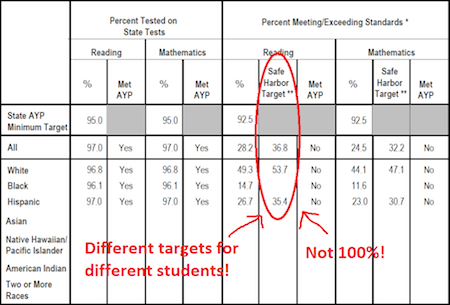The Chicago Tribune thinks it found a potential scandal. Writing about Illinois’ newly approved NCLB waiver, it breathlessly reported that, “Under a dramatic new approach to rating public schools, Illinois students of different backgrounds no longer will be held to the same standards — with Latinos and blacks, low-income children and other groups having lower targets than whites for passing state exams, the Tribune has found.”
The only thing scandalous here is that the Chicago Tribune didn’t know this was already federal law and, contrary to it being a “dramatic new approach,” Illinois has been required to set different standards for different groups of students for more than a decade now. The piece quoted Timothy Truesdale, an assistant superintendent in Cicero’s Morton High School District 201, saying, “You’re potentially sending a message that it’s OK for some kids to not do as well…We want our students to be proficient.” Nevermind that only 28.2 percent students in the Morton school district are proficient in reading and only 24.5 percent in math, and that both of those rates have been stuck below 30 percent for the last five years, what the Tribune and Truesdale neglected to point out is that Morton’s white students, black students, Hispanic students, poor students, non-poor students, and students with disabilities are all held to different standards already.
Under a provision in the federal No Child Left Behind Act called “safe harbor,” states must set different standards for different groups. (It’s written in complicated statutory language, but Section 1111(b)(2)(I)(i) has been federal law since 2002.) Rather than holding all students to the same bar, it gives credit to lower-performing groups that demonstrate progress, even if they don’t fully close the entire achievement gap. To show what this looks like, I pulled the 2013 Illinois report card for the Morton school district. For each group of students of sufficient size (Morton doesn’t have enough Asian students to report their scores separately, for example), the report card lists the percentage of students Meeting/ Exceeding Standards in Reading and Mathematics. It also lists the safe harbor target for each group. Contrary to popular understanding, note that none of these goals was 100 percent or anywhere close to it. The goals won’t be 100% in 2014 either, because Morton has new targets in 2014 based on how they performed last year. Every year, each group in the district has its own unique target, and lower-performing student groups have lower targets.
(By the way, you can also see from the chart that NONE of Morton’s subgroups met their unique performance standards last year.)

Just to be clear, this flexibility is a GOOD thing. If we demanded all schools and subgroups met the same bar each year, we’d either set the bar too low or punish anyone who didn’t meet it. The safe harbor provision in NCLB was a crude way to measure growth, but it at least attempted to account for the fact that not all students come in with the same achievement levels and we can’t expect schools to erase those gaps in a single year. What safe harbor does, and what Illinois is now doing under a slightly different formula, is to set different expectations for different students while simultaneously expecting lower-performing groups make more progress over time and slowly close persistent achievement gaps. It’s crazy that this even needs defending.
—Chad Aldeman


